Uranus
Contents
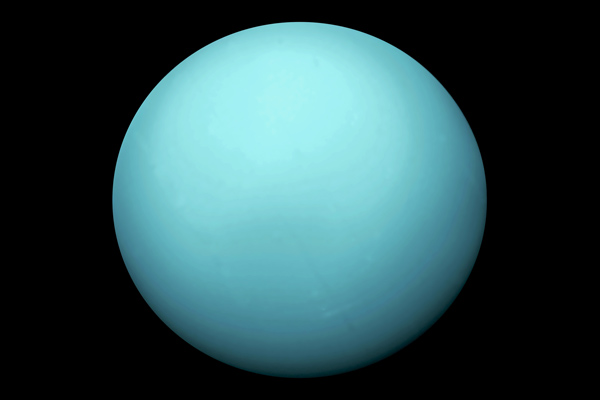 Planet Uranus by Voyager 2 in 1986 / wikimedia.org
Planet Uranus by Voyager 2 in 1986 / wikimedia.orgOne of our solar system's most unusual planets would have to be Uranus. There are two pronunciations for this bazaar planet, but the most commonly used in the scientific world is Ur-uh-nus, but the common way it is said outside the scientific community is Ur-a-nus. Either way, the name derives from the Greek lord of the skies Ouranos.
Early observations of Uranus were recorded by astronomer Hipparchos in 128 BC but he thought it was a star. On March 13, 1781, William Herschel observed Uranus through a telescope and mistook it for a comet proposing to name it Georgian Sidus after King George III. It was not for months later that it was determined that Uranus was a planet and not a comet by the scientific community and was named Uranus.
Because of its distance, there has been little observations of Uranus except through near-Earth telescopes and a single probe, Voyager 2, as it flew by. Compared to other planets, it is relatively unremarkable other than it is sideways and it rotates backward.
Position to the Sun
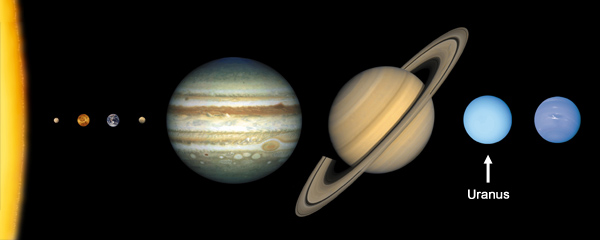 Position of Uranus in the Solar System / nasa.gov
Position of Uranus in the Solar System / nasa.govUranus is approximately 3 billion km (1.89 billion miles) from the sun. It rotates on an extreme axial tilt of 97.77° and one day is only 17 hours on Uranus, however, it takes the planet 84 years to complete its rotation around the sun at an orbital speed of 6.83 kilometers per second. One strange aspect of this planet is that only one of its poles see's the sun at a time, this happens every 42 years. Another oddity, not only does it rotate backward, West to East, but also the planet is on its side. So its poles appear to be on the East and West sides of the planet and the planet is rotating from North to South.
One theory on this oddity is that a large object collided with Uranus' during its early history and tipped it over onto its side. However, there is no evidence to support this theory and there are too many variables that make this theory unlikely. So until we are able to finally visit and study the planet, this is a question that may never be truly answered.
Internal Structure
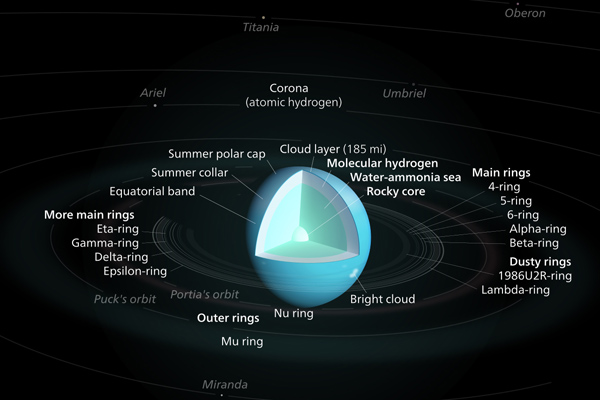 Structure of Uranus / wikipedia.org
Structure of Uranus / wikipedia.orgUranus' mass is 14.5 times that of Earth's and it is 4 times larger than the Earth. Scientist believe that its core is made of a rock (silicate and iron-nickel) but that it does not have a solid surface beneath the clouds of its atmosphere but descends down into a deep thick liquid icy mantle instead. The pressures becoming so intense, 800 GPa (Earth's is only 364 GPa), that it is strongly believed that there are diamonds surrounding the core of the planet.
Surface/Geography
Because it is a gas giant, Uranus has no solid surface. Once you are past the gaseous clouds of hydrogen and helium you would encounter liquid versions of these elements. However, because of the intense cold of the planet, this liquid would be thick and icy. It is unknown if there is rain on the planet.
The pressure index on the planet, however, would be intense. This pressure is enough that the carbons within the core would be smashed together enough to create diamonds. Most of what we know of Uranus is speculation and theory at this time. Little else is truly known about this planet.
Atmosphere/Climate
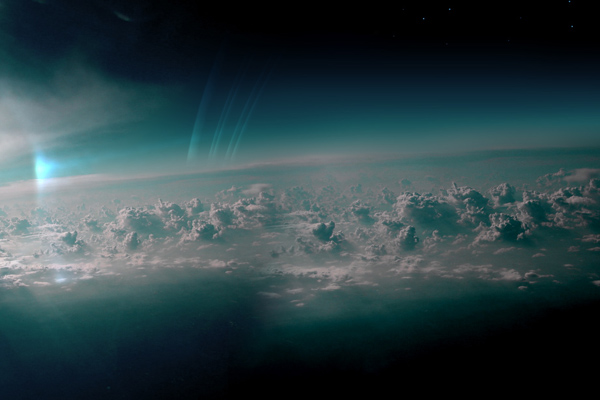 Artist's impression of Uranus' atmosphere / deviantart.com
Artist's impression of Uranus' atmosphere / deviantart.comLike all the other gas giants in the solar system, Uranus' atmosphere is comprised primarily of hydrogen and helium in gaseous form. It's soft blue hue comes from the 2% Methane within its upper atmosphere.
When they first observed Uranus', scientist were disappointed as all they saw was a plain inactive planet. On closer observations, however, it was revealed a very lively planet with violent storms and it turns out that Uranus is the coldest planet in the solar system, colder even than Neptune. At its tropopause, the lower layer of its atmosphere, temperatures measured at 49K (-224.15°C or -371.47°F).
From March to May of 2004, large clouds formed and a mass of lightning began. They called this large thunderstorm the "Fourth of July Fireworks". It was an exciting time for scientist because Uranus went from a bland planet to one with activity though it is still yet to be known what caused this sudden display.
Satellites and Moons
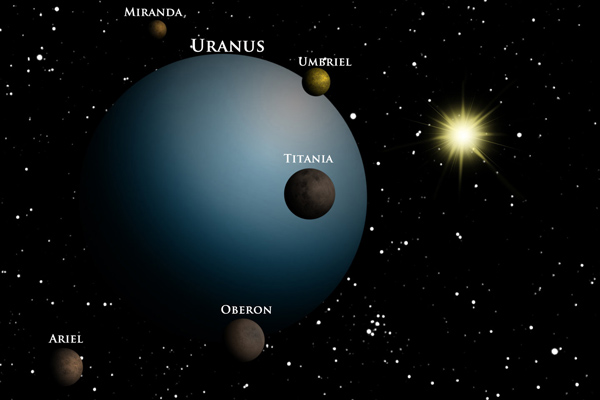 Uranus and its 5 satellites / deviantart.com
Uranus and its 5 satellites / deviantart.comCurrently, Uranus has 5 major satellites, 13 inner moons, and 9 irregular moons. They orbit in an erratic formation around Uranus with their orbits coming extremely close to crossing. It is believed that over time they will cross paths and collide with one another, but this will not occur for another 100 million years. One of its most notable satellites is Miranda. Heavily scarred with grooves and broken terrain, it is the closest to the planet with a high unexplained orbital plane that has yet to be understood. For More information on Uranus' satellites and moons visit this page.
Uranus' Rings
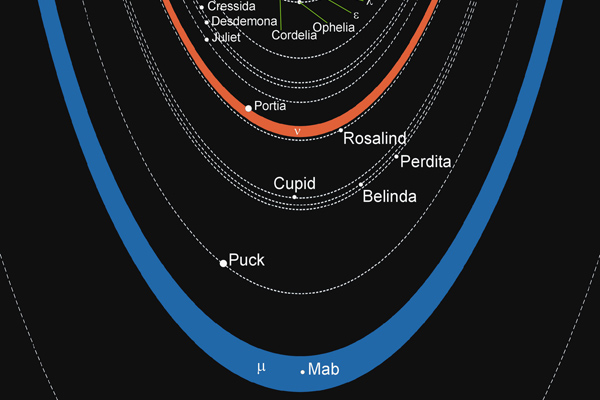 Rings of Uranus / wikipedia.org
Rings of Uranus / wikipedia.orgThere are 9 inner rings and 4 outer rings that surround Uranus and they are as unusual as the planet. They are made up of dark material so are very difficult to see even when there is sunlight directly on them. They surround the planet around the equator just as Saturn's rings do, but because the planet is on its side it makes it appear like a large target in the solar system with Uranus being the bullseye in the center. They are very thin at only a few kilometers wide each and are filled with a rocky material. It is believed that like Saturn's rings, they were created by a collision of long ago moons and the rocky material is what remains.
Exploration
Voyager 2 has been the only probe to go near Uranus on its flight towards the outer edges of our solar system. It recorded Uranus unusual tilt and the rings and sent back data of its magnetic field and additional moons were discovered. No other missions have been planned to visit with Uranus in the future and most observations of the planet are done by near-Earth telescopes.
See also: All planets, Objects
Video Gallery

-
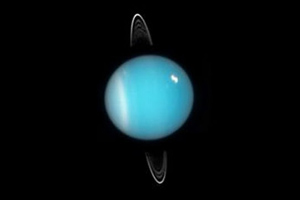 What Makes Uranus' Axial Tilt so Unusual?
What Makes Uranus' Axial Tilt so Unusual?
-
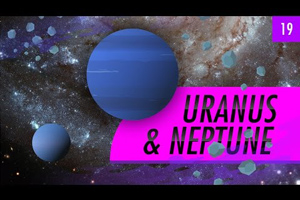 Uranus & Neptune: Crash Course Astronomy
Uranus & Neptune: Crash Course Astronomy
-
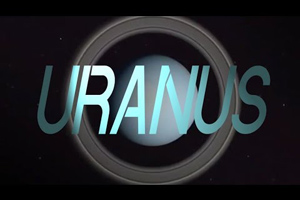 8 facts about: Uranus
8 facts about: Uranus
-
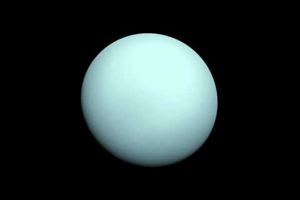 Sounds of Uranus - NASA Voyager Recording
Sounds of Uranus - NASA Voyager Recording